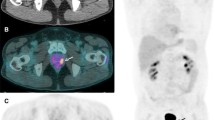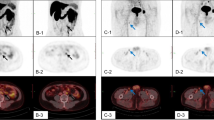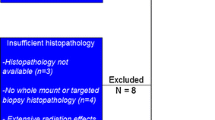Abstract
Objective
Increased FDG uptake in the prostate can be caused by both benign and malignant conditions. The purpose of this pictorial review is to demonstrate a spectrum of prostate lesions which can show increased FDG uptake on PET/CT imaging.
Conclusion
Various prostate lesions can show increased FDG uptake. Knowledge of the uptake characteristics of these lesions may be helpful for increasing diagnostic accuracy.















Similar content being viewed by others
References
Hwang I, Chong A, Jung SI, et al. (2013) Is further evaluation needed for incidental focal uptake in the prostate in 18-fluoro-2-deoxyglucose positron emission tomography-computed tomography images? Ann Nucl Med 27:140–145
Sayed MH, Farghaly HR, Nguyen NC, et al. (2010) Interesting image. Extrapulmonary small cell carcinoma in prostate: detection with F-18 FDG PET/CT. Clin Nucl Med 35:38–39
Yilmaz M, Celen Z, Sevinc A, Karakok M (2009) Widespread metastases in small cell carcinoma of the prostate on FDG PET/CT. Clin Nucl Med 34:598–600
de Carvalho Flamini R, Yamaga L, Mello ME, et al. (2010) F-18 FDG PET/CT imaging in small cell prostate cancer. Clin Nucl Med 35:452–453
Ho L, Quan V, Henderson R, Seto J (2007) High-grade urothelial carcinoma of the prostate on FDG PET-CT. Clin Nucl Med 32:746–747
Komura K, Inamoto T, Tsuji M, et al. (2010) Basal cell carcinoma of the prostate: unusual subtype of prostatic carcinoma. Int J Clin Oncol 15:594–600
Wong CS, Chu YC, Khong PL (2011) Unusual features of gastrointestinal stromal tumor on PET/CT and CT imaging. Clin Nucl Med 36:e1–e7
Solis V, Rosenberg RJ, Spencer RP (2005) B cell lymphoma: a case with localized involvement of the prostate on F-18-FDG examination. Clin Nucl Med 30:236–237
Chang JM, Lee HJ, Lee SE, et al. (2008) Pictorial review: unusual tumours involving the prostate: radiological-pathological findings. Br J Radiol 81:907–915
Varghese SL, Grossfeld GD (2000) The prostatic gland: malignancies other than adenocarcinomas. Radiol Clin North Am 38:179–202
Humphrey PA (2010) Histological variants of prostatic carcinoma and their significance. Histopathology 60:59–74
Kessler B, Albertsen P (2003) The natural history of prostate cancer. Urol Clin North Am 30:219–226
Kumar R, Zhuang H, Alavi A (2004) PET in the management of urologic malignancies. Radiol Clin North Am 42:1141–1153
Oyama N, Akino H, Suzuki Y, et al. (1999) The increased accumulation of [18F]fluorodeoxyglucose in untreated prostate cancer. Jpn J Clin Oncol 29:623–629
Effert P, Beniers AJ, Tamimi Y, Handt S, Jakse G (2004) Expression of glucose transporter 1 (Glut-1) in cell lines and clinical specimens from human prostate adenocarcinoma. Anticancer Res 24:3057–3063
Liu IJ, Zafar MB, Lai YH, Segall GM, Terris MK (2001) Fluorodeoxyglucose positron emission tomography studies in diagnosis and staging of clinically organ-confined prostate cancer. Urology 57:108–111
Sung J, Espiritu JI, Segall GM, Terris MK (2003) Fluorodeoxyglucose positron emission tomography studies in the diagnosis and staging of clinically advanced prostate cancer. BJU Int 92:24–27
Shreve PD, Grossman HB, Gross MD, Wahl RL (1996) Metastatic prostate cancer: initial findings of PET with 2-deoxy-2-[F-18]fluoro-d-glucose. Radiology 199:751–756
Barloon TJ, Foderaro AE, Kramolowsky EV (1988) Giant prostate carcinoma: computed tomography findings and review of previous reports. J Comput Tomogr 12:49–53
Njinou Ngninkeu B, Lorge F, Moulin P, Jamart J, Van Cangh PJ (2003) Transitional cell carcinoma involving the prostate: a clinicopathological retrospective study of 76 cases. J Urol 169:149–152
Patil VV, Wang ZJ, Sollitto RA, et al. (2009) 18F-FDG PET/CT of transitional cell carcinoma. AJR Am J Roentgenol 193:W497–W504
Jadvar H, Quan V, Henderson RW, Conti PS (2008) [F-18]-Fluorodeoxyglucose PET and PET-CT in diagnostic imaging evaluation of locally recurrent and metastatic bladder transitional cell carcinoma. Int J Clin Oncol 13:42–47
Kanthan R, Torkian B (2004) Squamous cell carcinoma of the prostate. A report of 6 cases. Urol Int 72:28–31
Nabi G, Ansari MS, Singh I, Sharma MC, Dogra PN (2001) Primary squamous cell carcinoma of the prostate: a rare clinicopathological entity. Report of 2 cases and review of literature. Urol Int 66:216–219
Suzawa N, Ito M, Qiao S, et al. (2011) Assessment of factors influencing FDG uptake in non-small cell lung cancer on PET/CT by investigating histological differences in expression of glucose transporters 1 and 3 and tumour size. Lung Cancer 72:191–198
Imperiale A, Cimarelli S, Brigand C, et al. (2011) Does the association of 18F-FDG uptake intensity and lesion topography reveal histological phenotype and tumor differentiation in esophageal cancer? Hell J Nucl Med 14:239–242
Dong A, Zuo C, Lu J, Wang Y (2013) Squamous cell carcinoma of the prostate with strong FDG uptake on PET/CT. Clin Nucl Med. doi:10.1097/RLU.0b013e31829af937
Begnami MD, Quezado M, Pinto P, Linehan WM, Merino M (2007) Adenoid cystic/basal cell carcinoma of the prostate: review and update. Arch Pathol Lab Med 131:637–640
Ayyathurai R, Civantos F, Soloway MS, Manoharan M (2007) Basal cell carcinoma of the prostate: current concepts. BJU Int 99:1345–1349
Ali TZ, Epstein JI (2007) Basal cell carcinoma of the prostate: a clinicopathologic study of 29 cases. Am J Surg Pathol 31:697–705
Terris MK (1999) The appearance of adenoid cystic carcinoma of the prostate on transrectal ultrasonography. BJU Int 83:875–876
Segawa N, Tsuji M, Nishida T, et al. (2008) Basal cell carcinoma of the prostate: report of a case and review of the published reports. Int J Urol 15:557–559
Song YS, Lee WW, Chung JH, et al. (2008) Correlation between FDG uptake and glucose transporter type 1 expression in neuroendocrine tumors of the lung. Lung Cancer 61:54–60
Chong S, Lee KS, Kim BT, et al. (2007) Integrated PET/CT of pulmonary neuroendocrine tumors: diagnostic and prognostic implications. Am J Roentgenol 188:1223–1231
Kamel EM, Zwahlen D, Wyss MT, et al. (2003) Whole-body (18)F-FDG PET improves the management of patients with small cell lung cancer. J Nucl Med 44:1911–1917
Gregory DL, Brennan SM, Stillie A, et al. (2010) Impact of 18-F-fluorodeoxyglucose positron emission tomography in the staging and treatment response assessment of extra-pulmonary small-cell cancer. J Med Imaging Radiat Oncol 54:100–107
Dong A, Zuo C, Wang Y (2013) FDG PET/CT imaging of extrapulmonary small cell carcinoma of the adrenal gland. Clin Nucl Med 38:e407–e410
Paner GP, Aron M, Hansel DE, Amin MB (2012) Non-epithelial neoplasms of the prostate. Histopathology 60:166–186
Gaudin PB, Rosai J, Epstein JI (1998) Sarcomas and related proliferative lesions of specialized prostatic stroma: a clinicopathologic study of 22 cases. Am J Surg Pathol 22:148–162
Herawi M, Epstein JI (2006) Specialized stromal tumors of the prostate: a clinicopathologic study of 50 cases. Am J Surg Pathol 30:694–704
Hansel DE, Herawi M, Montgomery E, Epstein JI (2007) Spindle cell lesions of the adult prostate. Mod Pathol 20:148–158
Cheville JC, Dundore PA, Nascimento AG, et al. (1995) Leiomyosarcoma of the prostate. Report of 23 cases. Cancer 76:1422–1427
Sexton WJ, Lance RE, Reyes AO, et al. (2001) Adult prostate sarcoma: the MD Anderson Cancer Center experience. J Urol 166:521–525
Vandoros GP, Manolidis T, Karamouzis MV, et al. (2008) Leiomyosarcoma of the prostate: case report and review of 54 previously published cases. Sarcoma 2008:458709
Charest M, Hickeson M, Lisbona R, et al. (2009) FDG PET/CT imaging in primary osseous and soft tissue sarcomas: a retrospective review of 212 cases. Eur J Nucl Med Mol Imaging 36:1944–1951
Punt SE, Eary JF, O’Sullivan J, Conrad EU (2009) Fluorodeoxyglucose positron emission tomography in leiomyosarcoma: imaging characteristics. Nucl Med Commun 30:546–549
Agrons GA, Wagner BJ, Lonergan GJ, Dickey GE, Kaufman MS (1997) From the archives of the AFIP. Genitourinary rhabdomyosarcoma in children: radiologic-pathologic correlation. Radiographics 17:919–937
Parham DM (2001) Pathologic classification of rhabdomyosarcomas and correlations with molecular studies. Mod Pathol 14:506–514
Bisceglia M, Magro G, Carosi I, Cannazza V, Ben Dor D (2011) Primary embryonal rhabdomyosarcoma of the prostate in adults: report of a case and review of the literature. Int J Surg Pathol 19:831–837
Tateishi U, Hosono A, Makimoto A, et al. (2009) Comparative study of FDG-PET/CT and conventional imaging in the staging of rhabdomyosarcoma. Ann Nucl Med 23:155–161
Al-Agha OM, Igbokwe AA (2008) Malignant fibrous histiocytoma: between the past and the present. Arch Pathol Lab Med 132:1030–1035
Kransdorf MJ (1995) Malignant soft-tissue tumors in a large referral population: distribution of diagnoses by age, sex, and location. Am J Roentgenol 164:129–134
Aoki J, Watanabe H, Shinozaki T, et al. (2003) FDG-PET for preoperative differential diagnosis between benign and malignant soft tissue masses. Skeletal Radiol 32:133–138
Coffin CM, Dehner LP (1989) Peripheral neurogenic tumors of the soft tissues in children and adolescents: a clinicopathologic study of 139 cases. Pediatr Pathol 9:387–407
Jürgens H, Bier V, Harms D, et al. (1988) Malignant peripheral neuroectodermal tumors. A retrospective analysis of 42 patients. Cancer 61:349–357
Györke T, Zajic T, Lange A, et al. (2006) Impact of FDG-PET for staging of Ewing sarcomas and primitive neuroectodermal tumours. Nucl Med Commun 27:17–24
Meltzer CC, Townsend DW, Kottapally S, Jadali F (1998) FDG imaging of spinal cord primitive neuroectodermal tumor. J Nucl Med 39:1207–1209
Dong A, Wang Y, Lu J, Zuo C (2013) FDG PET/CT in peripheral primitive neuroectodermal tumor of the retroperitoneum. Clin Nucl Med. doi:10.1097/RLU.0b013e318292f38e
Aras M, Dede F, Dane F, Aktas B, Turoglu HT (2013) FDG PET/CT appearance of portal vein tumor thrombus in the gastric primitive neuroectodermal tumor: uncommon primary tumor site with rare finding. Clin Nucl Med 38:47–49
Watanabe N, Kawano M, Takada M, et al. (2006) F-18 FDG-PET imaging in a primitive neuroectodermal tumor. Clin Nucl Med 31:484–485
Musana KA, Raja S, Cangelosi CJ, Lin YG (2006) FDG PET scan in a primitive neuroectodermal tumor. Ann Nucl Med 20:221–225
Jun L, Ke S, Zhaoming W, Linjie X, Xinru Y (2008) Primary synovial sarcoma of the prostate: report of 2 cases and literature review. Int J Surg Pathol 16:329–334
Murphey MD, Gibson MS, Jennings BT, et al. (2006) From the archives of the AFIP: imaging of synovial sarcoma with radiologic-pathologic correlation. Radiographics 26:1543–1565
Ferrari A, Gronchi A, Casanova M, et al. (2004) Synovial sarcoma: a retrospective analysis of 271 patients of all ages treated at a single institution. Cancer 101:627–634
Lisle JW, Eary JF, O’Sullivan J, Conrad EU (2009) Risk assessment based on FDG-PET imaging in patients with synovial sarcoma. Clin Orthop Relat Res 467:1605–1611
Gold JS, Antonescu CR, Hajdu C, et al. (2002) Clinicopathologic correlates of solitary fibrous tumors. Cancer 94:1057–1068
Herawi M, Epstein JI (2007) Solitary fibrous tumor on needle biopsy and transurethral resection of the prostate: a clinicopathologic study of 13 cases. Am J Surg Pathol 31:870–876
Moureau-Zabotto L, Chetaille B, Bladou F, et al. (2012) Solitary fibrous tumor of the prostate: case report and review of the literature. Case Rep Oncol 5:22–29
Wakisaka N, Kondo S, Murono S, et al. (2009) A solitary fibrous tumor arising in the parapharyngeal space, with MRI and FDG-PET findings. Auris Nasus Larynx 36:367–371
Gorospe L (2012) Giant benign solitary fibrous tumor of the pleura: PET/CT findings. Clin Nucl Med 37:702–704
Migita K, Watanabe A, Nakagawa K, Ohyama T, Sekigawa S (2009) Solitary fibrous tumor of the abdominal wall. Int J Clin Oncol 14:555–559
Santambrogio L, Nosotti M, Palleschi A, et al. (2008) Solitary fibrous tumor of the pleura presenting with syncope episodes when coughing. World J Surg Oncol 6:86
Yan J, Jones RL, Lewis DH, Eary JF (2013) Impact of (18)F-FDG-PET/CT imaging in therapeutic decisions for malignant solitary fibrous tumor of the pelvis. Clin Nucl Med 38:453–455
Miettinen M, Lasota J (2006) Gastrointestinal stromal tumors: pathology and prognosis at different sites. Semin Diagn Pathol 23:70–83
Reith JD, Goldblum JR, Lyles RH, Weiss SW (2000) Extragastrointestinal (soft tissue) stromal tumors: an analysis of 48 cases with emphasis on histologic predictors of outcome. Mod Pathol 13:577–585
Basu S, Mohandas KM, Peshwe H, Asopa R, Vyawahare M (2008) FDG-PET and PET/CT in the clinical management of gastrointestinal stromal tumor. Nucl Med Commun 29:1026–1039
Park JW, Cho CH, Jeong DS, Chae HD (2011) Role of F-fluoro-2-deoxyglucose Positron Emission Tomography in Gastric GIST: Predicting Malignant Potential Pre-operatively. J Gastric Cancer 11:173–179
Eslamy HK, Quon A (2008) PET/CT imaging of gastrointestinal stromal tumor with calcified peritoneal implants after imatinib therapy. Clin Nucl Med 33:864–865
Antoch G, Kanja J, Bauer S, et al. (2004) Comparison of PET, CT, and dual-modality PET/CT imaging for monitoring of imatinib (STI571) therapy in patients with gastrointestinal stromal tumors. J Nucl Med 45:357–365
Gong N, Wong CS, Chu YC (2011) Is lymph node metastasis a common feature of gastrointestinal stromal tumor? PET/CT correlation. Clin Nucl Med 36:678–682
Chu PG, Huang Q, Weiss LM (2005) Incidental and concurrent malignant lymphomas discovered at the time of prostatectomy and prostate biopsy: a study of 29 cases. Am J Surg Pathol 29:693–699
Bostwick DG, Iczkowski KA, Amin MB, Discigil G, Osborne B (1998) Malignant lymphoma involving the prostate: report of 62 cases. Cancer 83:732–738
Kwee TC, Kwee RM, Nievelstein RA (2008) Imaging in staging of malignant lymphoma: a systematic review. Blood 111:504–516
Hodgson R, Huang YT, Steinke K, Ravi Kumar AS (2010) FDG-PET/CT in evaluation and prognostication of primary prostate lymphoma. Clin Nucl Med 35:418–420
Li G, Dhawan M, Takalkar AM, Lilien DL (2011) FDG PET/CT imaging suggests lymphoma involving prostate may be more resistant to treatment. Clin Nucl Med 36:255–257
Cimarelli S, Lachenal F, Ricard F, et al. (2010) A case of advanced non-Hodgkin’s lymphoma involving the prostate: staging and treatment monitoring using F-18 FDG PET/CT imaging. Clin Nucl Med 35:425–427
Krieger JN, Nyberg L Jr, Nickel JC (1999) NIH consensus definition and classification of prostatitis. JAMA 282:236–237
Nishimori I, Kohsaki T, Onishi S, et al. (2007) IgG4-related autoimmune prostatitis: two cases with or without autoimmune pancreatitis. Intern Med 46:1983–1989
Yoshimura Y, Takeda S, Ieki Y, et al. (2006) IgG4-associated prostatitis complicating autoimmune pancreatitis. Intern Med 45:897–901
Uehara T, Hamano H, Kawakami M, et al. (2008) Autoimmune pancreatitis-associated prostatitis: distinct clinicopathological entity. Pathol Int 58:118–125
Stimac G, Reljic A, Spajic B, et al. (2009) Aggressiveness of inflammation in histological prostatitis–correlation with total and free prostate specific antigen levels in men with biochemical criteria for prostate biopsy. Scott Med J 54:8–12
Kao PF, Chou YH, Lai CW (2008) Diffuse FDG uptake in acute prostatitis. Clin Nucl Med 33:308–310
Arzola JM, Hawley JS, Oakman C, Mora RV (2007) A case of prostatitis due to Burkholderia pseudomallei. Nat Clin Pract Urol 4:111–114
Wilkinson C, Chowdhury F, Scarsbrook A, Smith J (2012) BCG-induced granulomatous prostatitis–an incidental finding on FDG-PET–CT. Clin Imaging 36:413–415
Ilgan S, Koca G, Gundogdu S (2009) Incidental detection of granulomatous prostatitis by F-18 FDG PET/CT in a patient with bladder cancer: a rare complication of BCG instillation therapy. Clin Nucl Med 34:613–614
Lin KH, Chen YS, Hu G, Tsay DG, Peng NJ (2010) Chronic bacterial prostatitis detected by FDG PET/CT in a patient presented with fever of unknown origin. Clin Nucl Med 35:894–895
Han EJ, HO J, Choi WH, Yoo IR, Chung SK (2010) Significance of incidental focal uptake in prostate on 18-fluoro-2-deoxyglucose positron emission tomography CT images. Br J Radiol 83:915–920
Almuhaideb A, Syed R, Iordanidou L, Saad Z, Bomanji J (2011) Fluorine-18-fluorodeoxyglucose PET/CT rare finding of a unique multiorgan involvement of Wegener’s granulomatosis. Br J Radiol 84:e202–e204
Zhang J, Shao C, Wang J, et al. (2012) (2013) Autoimmune pancreatitis: whole-body (18)F-FDG PET/CT findings. Abdom Imaging 38:543–549
Acknowledgments
Aisheng Dong was sponsored by Young Scholar Grant from National Natural Science Foundation of China (81000601). Changjing Zuo was sponsored by New Round of Shanghai Health System Excellent Discipline Leader Training Plan Fund (XBR2011040), Development Fund for Shanghai Talents (2010020), and Shanghai Postdoctoral Science Found (11R21410600).
Author information
Authors and Affiliations
Corresponding authors
Additional information
Aisheng Dong and Yushu Bai have contributed equally to this study.
Rights and permissions
About this article
Cite this article
Dong, A., Bai, Y., Wang, Y. et al. Spectrum of the prostate lesions with increased FDG uptake on 18F-FDG PET/CT. Abdom Imaging 39, 908–921 (2014). https://doi.org/10.1007/s00261-014-0114-0
Published:
Issue Date:
DOI: https://doi.org/10.1007/s00261-014-0114-0




